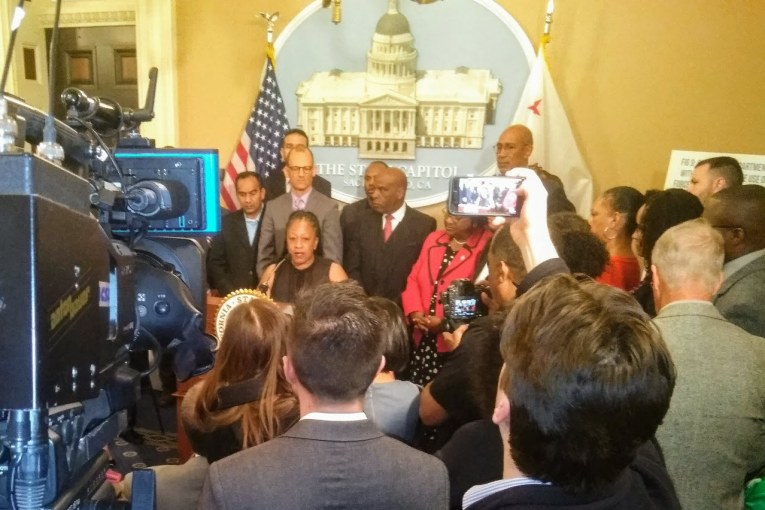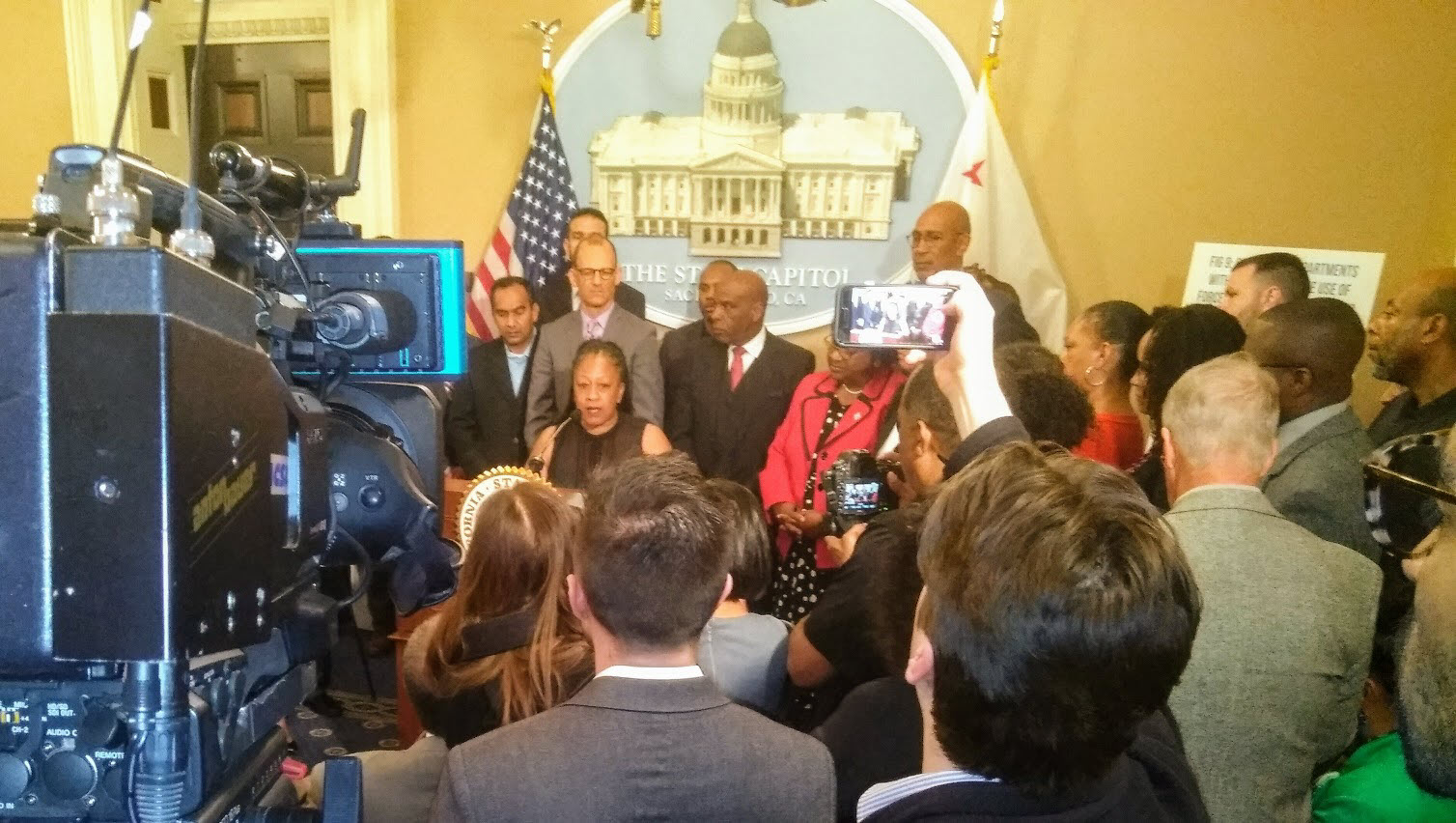

Yolo DA Candidate Among First to Support Bill
By Crescenzo Vellucci
SACRAMENTO – Action does not usually happen in a vacuum. If enough people get killed at a certain street corner, for instance, a stop light or stop sign will be eventually erected.
And if enough people – especially those unarmed – are killed by law enforcement, there will be legislation to attempt to curb that practice.
That is exactly what happened Tuesday at the State Capitol here when several Assemblymembers introduced legislation designed to make big changes in how police use lethal force against civilians.
The proposed legislation comes at a time in the state – and especially the capital city of Sacramento and neighboring Yolo County – when Black people are seemingly being gunned down regularly by law enforcement.
It hit some kind of a peak March 18 when 22-year-old Stephon Clark was shot eight times (20 shots were fired) as he tried to enter a family house where he lived. Sacramento police said he had a gun. He did not.
Only a cell phone.
The shooting of Clark has sparked nearly daily protests at City Hall, and through the city of Sacramento in its streets, and NBA arena (two NBA games were shut down with only a few 1,000 attending after protestors blocked entrances). To fan the flames, a Sacramento County Deputy Sheriff ran down a Stephon Clark shooting protestor Saturday and sent her to the hospital.
Assemblymembers Shirley Weber (D-San Diego) and Kevin McCarty (D-Sacramento) announced legislation that could, if enacted by the Democrat-controlled Legislature and heeded by police, change how  police treat suspects.
police treat suspects.
Dean Johansson, running for Yolo County District Attorney, was among the first to support the legislation, that would mandate officers fire their weapons only if “necessary,” not when they believe it’ “reasonable.”
There were 162 killings by California peace officers in 2017 – more than half were unarmed.
“It is urgent that we change our state laws to bring greater transparency and accountability to law enforcement. It’s the right thing to do and we owe it to the families of Stephon Clark, Michael Barrera, Luis Gutierrez and so many others to enact these long overdue reforms,” said Johansson, who has been a public defender and district attorney.
American Civil Liberties Union legislative advocate Lizzie Buchen Tuesday said the measure would require officers to shoot only if there were no other “reasonable alternatives to the use of deadly force.”
McCarty explained that peace officers would be required to show that shooting their weapons was the only option they had…he addressed questions members of the community have had by noting that officers could call for backup or wait for “reinforcements” instead of shooting to kill first.
In Stephon Clark’s situation, officers appeared to be secure behind the side of a house, yet they opened fire and emptied the weapons on a Black man “armed” only with a cell phone. Under the new law, they may not have had the right to open fire, but would have been mandated by policy to call for backup and secure the scene, firing only on Clark if he posed a real danger to them or others.
But peace officers generally are afforded special protections by the courts – the reason that officers often state that they are “in fear for my life” – those exact words – is that courts have made it clear they don’t want to Monday morning quarterback an officer if they are ‘”in fear” of their lives.
“This is a new broad coalition. But this is an old issue, rooted in our society and we must address the problem head-on. We know officers can do it; it’s happening in other communities. We want the community to look upon officers as friends and not be afraid to accept their protection,” said Weber.
“We are the subject of tyranny (in the Black communities) and a vicious system,” said Pastor Les Simmons of Area Congregations Together. He called for an “end to police violence and accountability” because the police are “out of control. I am tired of seeing blood in the streets.”
Other community speakers said the Black community has a “target” on its back, and called for the legislation as an “alternative to deadly force – shoot first and ask questions later. This is an epidemic; officers act like Black residents are enemy combatants.”
Other bill supporters note that while peace officers complain they have to make “split second decisions” in the field, the same goes for civilians when approached by officers who may kill them. “They have to decide whether to stay and be shot, or run.”
“If California can’t do it, who can?” asked Weber to end the press conference Tuesday.
The next step for the legislation is the Assembly Judiciary Committee later this month.

After watching the tape of the Clark shooting, I would suggest one very simple change that would not require any legislation, expenditure of more money, or anything other than a simple training change which could be implemented immediately. I would suggest that officers be trained to always announce themselves first in as normal a tone of voice that can be heard rather than shouting. This could be part of their fundamental training. It would have the effect of lowering adrenaline levels for all involved and lessening the chances of misunderstanding with lethal consequences.
I think hugs from the officers might be a good thing too.
This is really a game changer, it changes both the rules for when shots can be fired as well as eliminating the “fear of my life” defense.
David
“This is really a game changer, it changes both the rules for when shots can be fired as well as eliminating the “fear of my life” defense.”
This combination of changes within one ordinance has the possibility of being problematic. When you attempt to make multiple changes at one time, it can be difficult to sort out which policy made a positive or negative difference. I am by nature a cautious incrementalist and would prefer these not be combined.
Also, as I suggested previously, the time to “slow this down” as one of the officers said repeatedly was before, not after they fired. This is a training, not a legislative issue.
OK Tia… which increment should be adopted, and which deferred?
Keith
“I think hugs from the officers might be a good thing too.”
Do you see any downside to first identifying yourself calmly and in a normal tone as a police officer in a situation where the police are shielded ?
” I would suggest that officers be trained to always announce themselves first in as normal a tone of voice that can be heard rather than shouting. This could be part of their fundamental training.”
Exactly what I have advocated for years. (in this very space)
Maintaining composure is certainly part of the training I gave to public works employees.
edited
One way you can ensure quality customer service from your employees (and the public is the customer of law enforcement) is to train employees to demonstrate it. However, not all can be trained and it can be determined that the employee is not a good fit for the job and must be removed.
But in the public sector “business” the bad-fit employees get to hang around and pollute the work culture that then infects the other employees.
Too bad the state Democrats did not come to the table with legislation to assist police chiefs to get rid of the bad-fit cops. But then that would anger their union benefactors that fund Democrat political campaigns.
“Too bad the state Democrats did not come to the table with legislation to assist police chiefs to get rid of the bad-fit cops.”
I think this is a good point, although there is legislation that would open up police records to greater public scrutiny that could help in that regard.
The wording of this proposed legislation is flawed, ambiguous, and incomplete–probably as a result of the sentiment to rush this into the public limelight in the wake of the recent Sacramento shooting.
Amendments addressing use of deadly force would benefit with wording on the following crucial elements:
Use of, or the display of, deadly force is not allowed in misdemeanors, traffic offenses, or any felony property crime. Preservation of life has primacy when compared to the loss of property. “The display of,” addresses officers having weapons in hand when they have no legal justification to use them.
Any felony event where there is no demonstrative risk to officers or citizens. The argument, “They might do something bad later,” is speculative and never acceptable in defense of the use of deadly force.
If the identify of the offender is known, abandoning the pursuit is not only allowed by police policy, but encouraged. The warrant/complaint process is just as effective towards the interests of justice, and eliminates the need for a dangerous pursuit and resistance to physical custody, for everybody involved. To the points of both paragraphs above, bad guys are almost always caught and answer to the justice system eventually.
Deliberate impairment of any recording equipment during potential deadly force events is regarded as “obstruction of justice,” and cause for termination of the offending officer(s) as a first option.
Any circumstance where the suspect is “contained” within a geographical area, the active pursuit is suspended. Instead, responders are organized into a systematic search pattern of the perimeter (a routine police practice).
Makes sense to me, Phil… please forward to our reps and, actually, to all legislators… be sure to cite you credentials and experience. Dead dog serious about that.
Howard
“OK Tia… which increment should be adopted, and which deferred?”
I didn’t argue for adopting or deferring either. What I said was that combining creates confusion in attempts at future assessment of effectiveness.
Personally, I would like to see both. Just not combined in one bill.
Phil
Your explanation makes perfect sense. Unfortunately it seems in case after case, these basic principles are not followed and yet police are often not held accountable. Your thoughts on how best to remedy that situation would be ?